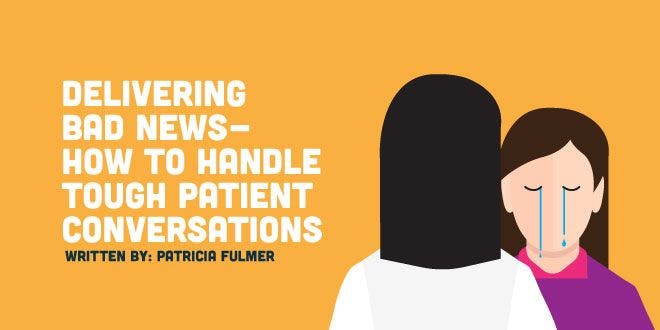As a whole, optometry is a pretty positive profession. Day in and day out, we are given the opportunity to improve someone's sight and therefore, improve their quality of life. It can be a very rewarding experience.
What happens, then, when we are faced with those not-so-happy cases? What do you say when a patient presents to your office and you discover a diagnosis that isn’t favorable?
As a doctor who practices in an exclusively secondary/tertiary setting, I have those conversations almost daily.
Some may be more mild, as in a newly diagnosed glaucoma patient, while others can be devastating, such as a nerve palsy that is the result of a potentially impending aneurysm or a stroke. While it's never easy to tell someone these sort of things, if you follow the recommendations below, you will soften the impact of the news and maximize your patient's ability to truly hear what you are saying.
Recommendation #1: Have as much information as you can about the patient's condition.
As you have probably heard at some point along the way, for many people, fear of the risk of blindness is second only to fear of death.
This means that for numerous patients, finding out that there is a condition present that may cause them to lose their sight is earth-shattering.
It is easy for us as eye care providers to become numb to words like glaucoma, macular degeneration, etc., but for our patients, these are foreign and terrifying concepts. Because of this, many questions tend to arise, and you should be prepared to answer to the best of your ability.
This means knowing exactly what you are diagnosing the patient with and why. Have your testing readily available so that you can walk through it with your patient. Be honest with them if you suspect a problem but need more testing or a referral to know for sure. Simply put, don't casually throw around diagnoses unless you have clinical reasoning to back it up.
Recommendation #2: Take your time.
When a person receives bad news of any type, it is the body and mind's immediate reaction to become overwhelmed and somewhat shut down.
This means that you, as the doctor, have a very limited amount of time in which to communicate with your patient before they stop absorbing most of what you are saying.
Have you ever had a conversation with a patient who seemed to be paying attention but then asked you the exact thing you just explained? Or who claimed at the next visit you never reviewed that with them? Sometimes this is because the patient just wasn't listening, but more often than not when it regards bad news, it is because your patient simply became scared and overwhelmed.
Try your best to explain things in a very plain, easy to understand manner, and speak slowly.
Make sure that you include the most important information that you want your patient to remember at the beginning of your discussion, and feel free to summarize or repeat yourself as much as you need to during the conversation.
End the interaction by having the patient explain to you in their own words what they heard. This will allow you to make sure they truly understood and gives you the opportunity to clear up any miscommunication.
Most importantly, don't rush through the conversation. Even if this means you fall behind slightly in clinic, the extra time spent with these patients will pay off in the end.
Recommendation #3: Don't over-explain.
Sometimes we get so caught up in being thorough that we forget that the majority of the population does not have a medical background. Over-explaining or going into too much depth can leave your patient feeling confused and "talked at" instead of "talked to."
Make sure you cover all the points that you feel it is important for the patient to know concerning their condition, particularly when dealing with the more serious conditions such as probable choroidal melanoma or a Horner’s that’s likely due to a Pancoast tumor. However, don’t dwell on testing or data that isn’t imperative to your ability to explain what’s going on.
Doing so will only cloud your patient's understanding and heighten the likelihood that they tune out during the conversation.
Recommendation #4: Be available to answer questions.
Always, always, always end these discussions by allowing the patient to ask you questions.
Engaging them in this way will give the chance to express any concerns or fears that may have arisen, as well as make them feel like you truly care about the circumstances. Additionally, let your patients know it is okay to call the office with questions should they get home and start thinking of things they wish had been asked. It is extremely common for new questions to formulate once a patient has had time to go home and digest what you've discussed.
Recommendation #5: Be compassionate.
This is quite possibly the most important thing for you to remember. We all get busy and stressed during clinic sometimes, and it's easy to allow that to cause us to rush or not explain things as well as we probably should.
However, try to put yourself in your patient's shoes, and try your best to remember that, most likely, they aren't a medical professional, and therefore, is hearing about the disease or condition for the first time.
Make sure that your patient knows that you truly do care about what happens to them.
I know this recommendation seems like common sense, but I promise you, it will go a very long way.
Delivering bad news is not fun and can be absolutely disheartening. However, by following these recommendations, those hard moments will be much easier for both you and your patient. Always keep in mind that, while you may have to have a tough discussion, in the end you are helping that person to receive the care that they need and potentially saving their vision and possibly life.
